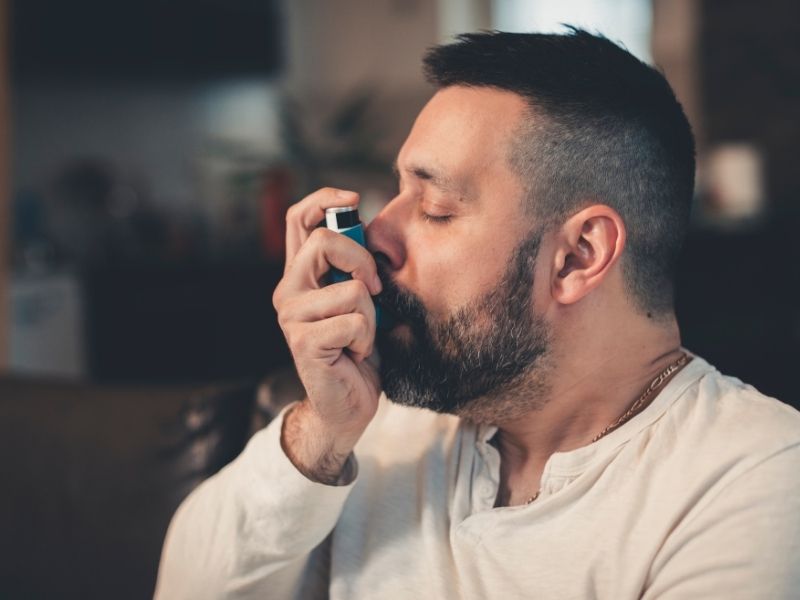Albuterol, better known as salbutamol, is a quick-relief medication used to prevent and/or treat shortness of breath caused by breathing problems such as asthma or other pulmonary diseases. The dosage is based on your medical condition and response to treatment. According to an NCBI study: “2 puffs of albuterol were not inferior to 4 puffs in the determination of bronchodilator responsiveness in our pediatric asthmatic patients”, making it safe if you accidentally took 3 puffs.
But exactly how much is too much albuterol? What can you do if you are taking too much without knowing it? Let’s find out everything we need to know about the topic.
How much albuterol is too much in a day?
Dosage will vary depending on how much a person needs the help of albuterol. Most doctors advise their patients to use the inhaler every 4 to 6 hours.

This does not include if you’re having an asthma attack. For the need for quick relief, you can safely use your inhaler as often as every 30-60 minutes for 2-3 hours without significant risk of harmful side effects.
In particular, unless you have a known severe heart condition, there is no danger to your heart when using bronchodilator inhalers with this frequency for a short period of time.
Common mistakes when using an albuterol inhaler

- Not following the instructions – Perhaps the most essential step in using your inhaler is reading the instruction or following the guidance of your doctor. You must do it the right way, or else it will not reach your air passage and will not be as effective.
- Not using the proper technique – There are two main types of inhalers – dry powder inhalers (DPIs) and metered dose inhalers (MDIs). Depending on which type you use, you’ll need to use a different inhaler technique.
- MDIs – Take a slow and steady breath. At the same time, press the canister on the inhaler once. Continue to breathe in slowly over 3 to 5 seconds until your lungs feel full.
- DPIs – For powder inhalers, you need to breathe in quickly and deeply until your lungs feel full. This makes sure the medicine is completely inhaled.
- Not breathing the air out before using the inhaler – When you breathe out as much air as you can just before taking your inhaler, you create more space in your lungs for your next breath. This means that you can breathe in deeper and longer when you inhale your asthma medicine, giving it the best chance of reaching the small airways deep inside your lungs.
- Not shaking your inhaler before using it – If you are using an MDI inhaler, it needs shaking before use to ensure the medicine and propellant mix properly, but other inhalers may not need shaking.
- Not having your chest straight – slouching restricts your lungs from fully inhaling the medicine and not fully exhaling most of the air out for the next puff, especially if you’re sitting down.
- Breathing in too early or too late – If you breathe in too early, your lungs won’t have enough time to finish breathing in all the medicine because it is already full. Some of the medicine will stick to your mouth or the back of your throat instead of being carried to your lungs where it’s needed. Whereas breathing in too late can make the medicine stick to your mouth or the back of your throat instead of getting to your lungs, especially if you’re not using a spacer.
- Not waiting between puffs – putting 30 seconds in between puffs gives the medicine and propellant enough time to mix if you are using metered-dose inhalers (MDI).
- Mouth not tight enough around the inhaler – make sure that your lips are not loose enough to let the air out when you take a puff by having your lips form a total seal around the end of your inhaler.
- Not holding your breath after each puff – it is ideal to hold your breath for 10 seconds after using your inhaler but holding it in for as long as you are comfortable will be beneficial. It is giving the medicine time to settle into your lungs.
- Not rinsing your mouth after using the inhaler – rinsing your mouth after using the inhaler will remove any medicine stuck in your mouth or throat is cleaned away. This will prevent side effects such as oral thrush.
FAQs
What are the common side effects of albuterol?
Side effects of albuterol include nervousness or shakiness, headache, throat or nasal irritation, and muscle aches.
More severe though less common, side effects include a rapid heart rate or feelings of fluttering or a pounding heart (palpitations).
What do you do if you take too much albuterol?
Overdose symptoms may include dry mouth, tremors, chest pain, fast heartbeat, nausea, general ill feeling, seizure, light-headedness, or fainting.
Please seek emergency medical attention because an overdose of albuterol can be fatal.
Conclusion
Following your doctor’s instructions, especially with how much dosage you should take, is vital in getting better. Still, we also know how our busy lives could get in the way of tracking our medicine sometimes, and it is entirely understandable.
If you feel like you overdosed on albuterol, don’t wait for more severe symptoms and reach out to your local health provider for help.


